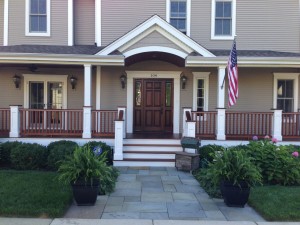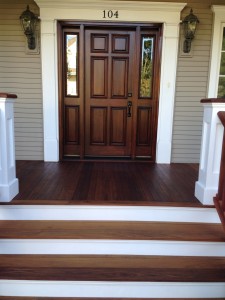Late last summer, our painting and decorating company was tasked with the refinishing of a front porch deck and the railings, as well as the refinishing of the front door system for a six-year-old house in the Northwest suburbs of Chicago. The decking was made of Ipe wood, the railings of Cedar wood and the front door of Doug Fir. Ipe is also known as Brazilian Walnut ad is one of densest hardwoods in existence. It is three times harder than cedar and is very heavy lumber.
Needless to say, creating color harmony between the different woods was very important to the client. To achieve the desired result, we had to resort to three different stain products, depending on the wood specie. Samples were prepared using similar woods. The client having specified Penofin as the product to use for the Ipe wood, it set the tone for the stain colors of the other two woods. Penofin is the Cadillac of finishes for Ipe and several other hardwood species. It is made of Brazilian Rosewood Oil and penetrates deeply into the wood and performs the best of any products I know of. In the long-run, it is also the easiest finish to maintain.
The major challenge we faced in refinishing the Ipe floor was that a different product had been used, the first time it was finished. We used a deck stripper to remove the old product and then sanded the whole deck floor. Strippers typically raise the grain of any wood. Normally, the sanding knocks off the dead wood fiber. However, we learned that , for a hard wood such as Ipe, the wood fiber is very soft, short and dense. It is similar to a peach fuzz. We tried sanding off that fuzz, with only very limited success. We ended up having to buff out the fuzz with an orbital sander and a soft foam pad covered with 1000-grit sandpaper. To achieve the desired finish, we had to wipe on two additional thin coats of Penofin, on top of the first coat.
Taking the additional finishing steps and doing the stain samples proved key in producing the look the client was after.









 Follow
Follow
